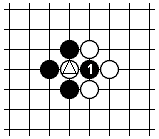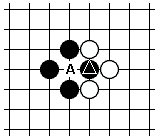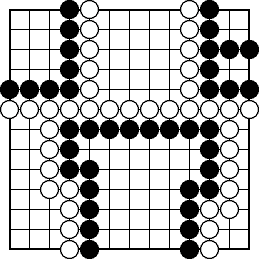The game of black and white - Weiqi
Updated: 2011-06-21 15:59
(China.org.cn)
|
|||||||||||
Ko
|
 |
 |
 |
| Figure 9 | Figure 10 | Figure 11 |
We start off with Figure 9, and black 1 takes away the white triangle piece in Figure 10, resulting in Figure 11. Now we can see that white may want to play at point A in Figure 11, and the pattern goes back to Figure 9. Then black decides to play at 1 at Figure 10 and so on, and the game will never end. Such a pattern is known as ko.
So when black 1 takes the ko in Figure 10, the rule for ko says that white has to wait one turn before he can take back the ko. This simply means that white cannot play at A in Figure 11 on his turn immediately after black takes the ko (white can play elsewhere), but he can play at A on his next turn. If white managed to take back the ko, the same rule applies to black: black has to wait one turn before he can take back the ko.
 |
| Figure 12 |
Figure 12 shows other valid examples of ko, involving the point A and the black triangle stone.
Ending a Game
A game is ended when both players agree that a game has ended – both players will pass on their consecutive turns. If one player passes but his opponent choose not to pass and make a move on the board, then the game will not end. When a game has ended, the winner is found by comparing territories (see next section – Section 6 on Territories).
Alternatively, if one player surrenders, his opponent automatically wins the game. In weiqi, a player may not place more than one piece on the board on his turn, so it is usual to place two pieces on the board to indicate that he surrenders. This is especially useful in overcoming language barriers between players with different cultural backgrounds.
Territories
The objective of weiqi is to obtain more territory than your opponent. It does not really matter what the difference is – so long your territory is more than your opponent’s, you win the game.
 |
| Figure 13 |
When we count territory, we count the number of points surrounded by the pieces. In Figure 13, black owns a territory of 9 points; white too claims 9 points as his territory.
When calculating who wins the game, due to the fact that pieces can be captured or removed from the board, we take into account the number of pieces as well. Therefore we find the sum of territories and number of pieces for a player and see if it is more than the opponent’s sum.
 |
| Figure 14 |
Consider Figure 14, a game played on the 13x13 board. Black and white have 39 pieces each. Black is surrounded by 45 empty points while white has 46. Adding them together, black has 84 points and white has 85 points. So white wins this game.
Komi
As the black player plays the first move on the board, black has an advantage over white. So in competitions or even friendly games, black has to compensate his advantage by automatically reducing his territory by a fixed amount known as the komi. In 19x19 board games, the komi is 8 points, so if black has a total of 183 points originally, he would have 8 points deducted and left with only 175 points. This ensures fairness in a game.